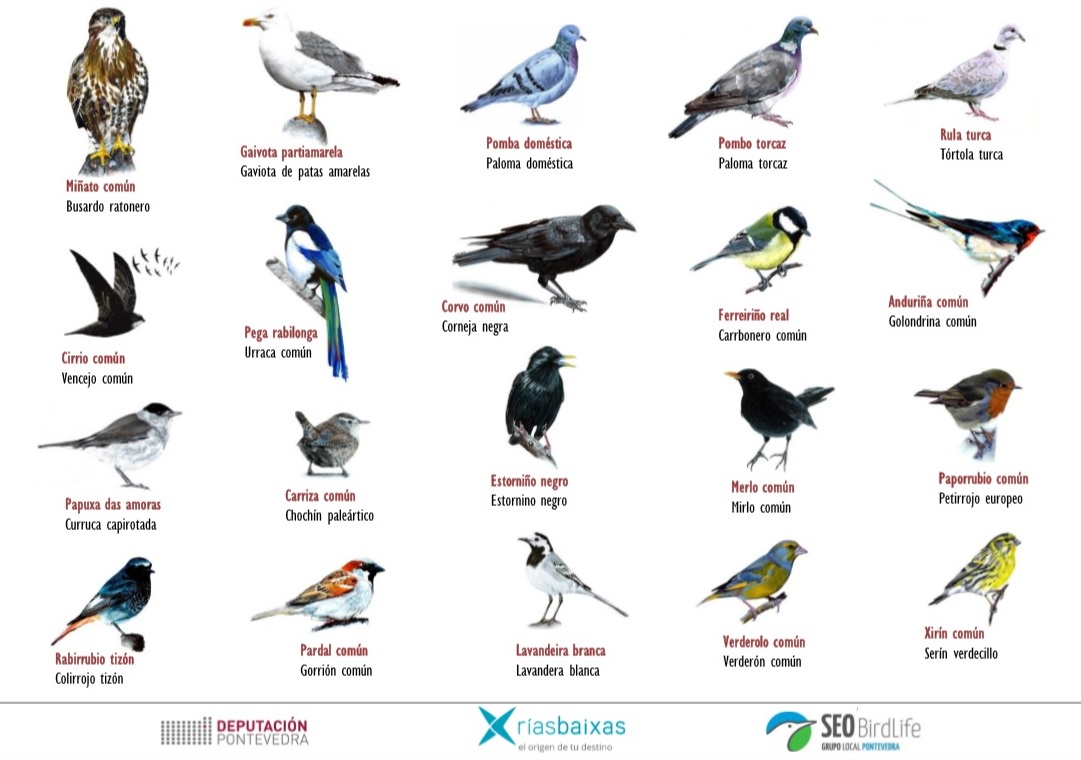Birds from home
The lack of human activity, the scarce noise we make during the lockdown and the beginning of spring will allow us to enjoy nature without leaving our home. Turismo Rías Baixas and SEO BirdLife offer you the possibility to learn more about it and, especially, about the bird world. Just open your window, watch and listen carefully. We will help you identify the birds and learn while taking notes in your field notebook.
The birds, always carefree and happy, can bring us closer to the new season and make us happier when we watch them or when we hear their tweets, especially at this time of the year, when they engage in frantic activity and songs, as they need to attract the females to match or mark their territory.
From our windows, we can hear and see urban birds that live in our towns and cities. They are highly beneficial: they eat millions of flies and mosquitos every year, they are a bioindicator of quality of life, and their optimism is contagious. A university study carried out in 2017 suggests that people who live in neighbourhoods with abundant fauna and vegetation are less likely to suffer from depression and stress. Birdwatching helps us feel calmer and more relaxed, proving that our connection with nature plays a crucial role for our mental well-being.
Great variety. House sparrows, collared doves, yellow-legged gulls, common woodpigeons, common blackbirds, European robins, white wagtails, spotless starlings, and countless other birds live with us all year round, although we barely notice them.
Moreover, during the change of season, we can enjoy watching migratory birds coming from for the distant lands of Africa, like barn swallows, which have just arrived, and the fearless common swifts, which in the month of April will alight on our buildings and cheer us up with their calls and aerial acrobatics on the streets and squares.
Now that you have the chance, Turismo Rías Baixas and SEO BirdLife encourage you to register all the species you watch using a small notebook as a field diary or through specific electronic resources, like the citizen science platform eBird or social media, where related data are published every day. You can share your sightings using #AvesDesdeCasa.
A useful guide for beginners
- From your balcony or window, take a few minutes to watch and listen carefully to the birds around us that cheer us up.
- You can make the most of your experience with a pair of binoculars or a camera. However, you can still enjoy it with the naked eye
- You will find the perfect moment to sight birds in the morning or at sunset
- In a small notepad or in a mobile app, you can create a field notebook to record your daily observations
How to create a field notebook
In this notepad you will write down:
- Date of observation: day, month and year
- Place of observation: street, town and province where the sighting took place
- Time of observation: start time and end time
- Weather conditions during the sighting (optional)
- Identified birds: common name and number of specimens seen or heard
- If you have children, you can even encourage them to draw the sighted bird
Available resources
Visit the Spanish Ornithological Society (SEO) website to find useful information about this exciting activity. Moreover, it also has a special section about birdwatching from home.
And if you want an excellent bird guide for free, you can download the app Aves de España to your mobile phone. This app contains information about all the Spanish birds: descriptions, images and features of their sounds.
You can download eBird and contribute with your records to citizen science. The eBird platform allows you to upload the information of all identified birds to an international database, which may be useful to future researches carried out all over the world. You will play an active and direct role in the conservation of birds.
You can also enjoy birdwatching from your sofa, since images of some of the most representative specimens of our fauna, such as the black vulture, the lesser kestrel, the peregrine falcon or the white stork, are broadcast live on SEO/BirdLife webcams.









